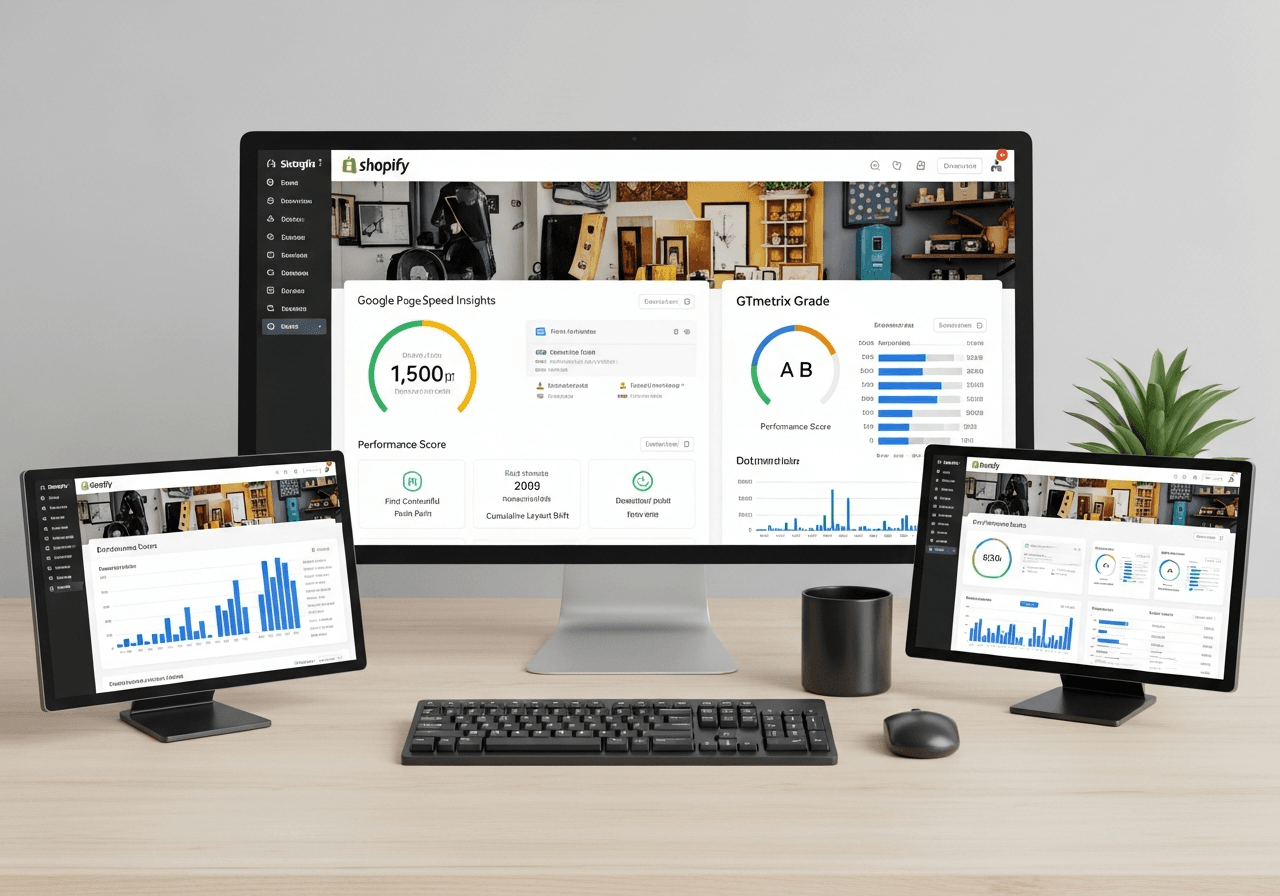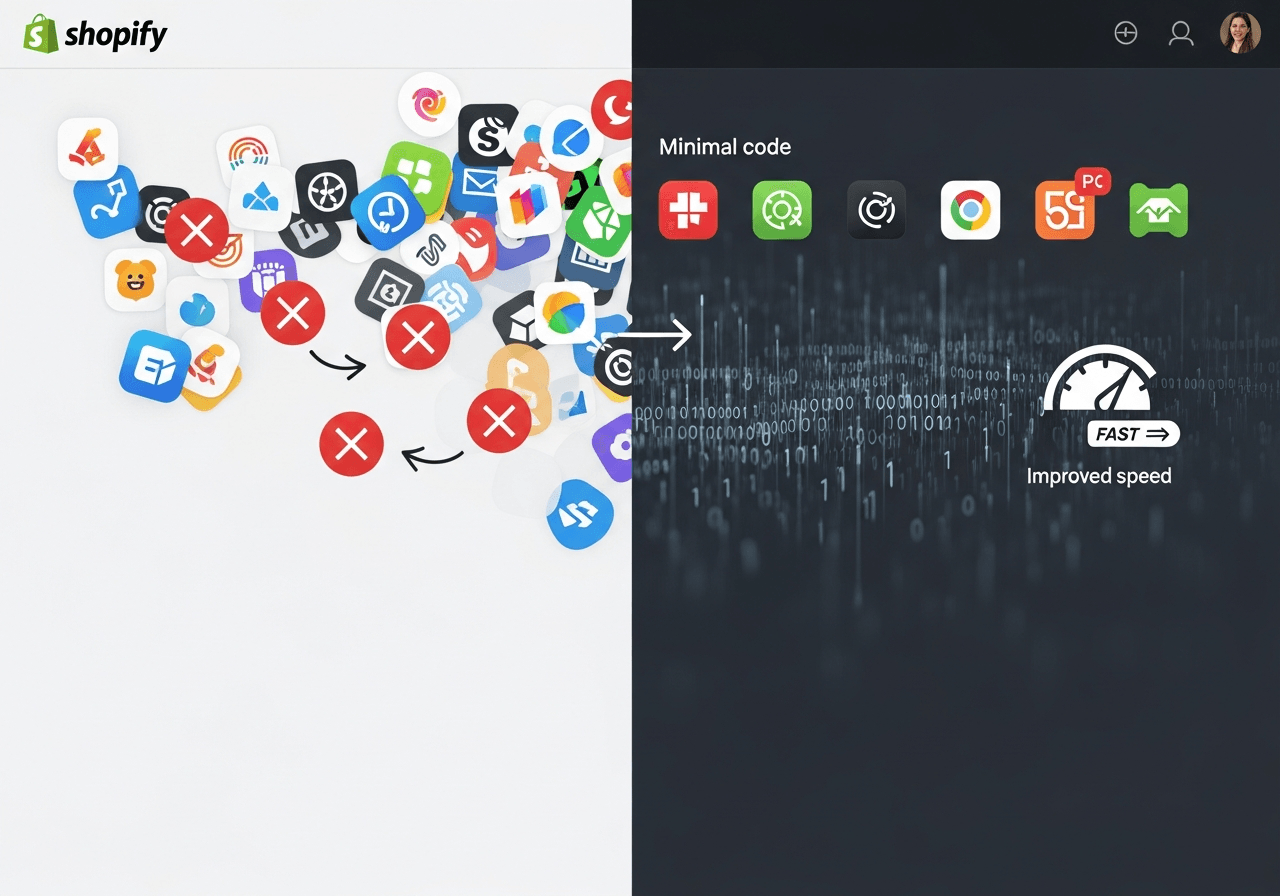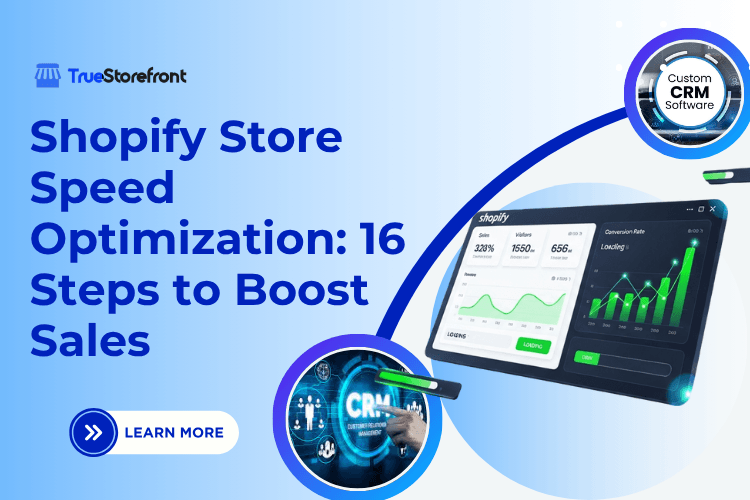In eCommerce, timing is everything. A slow Shopify store does more than just annoy visitors, it literally sucks out profits. Studies have shown that even a 1-second delay in page response can increasingly reduce conversions by 7%. For Shopify sellers, that can mean hundreds up to thousands of dollars a month.
Store performance is closely related to customer satisfaction, search engine rankings and sales finalization. Luckily for us, Shopify is a strong platform that reacts well to the right optimization tactics. This extensive article will guide you through a variety of Shopify store speed optimization approaches that help you speed up your Shopify store load time and make it run faster to provide fast loading pages, browse smoothly with high converting metrics, as recommended by an SEO expert New York.
Shopify store speed optimization strategies have been proven effective by leading digital marketing professionals and can transform your store's performance significantly.
Shopify store speed optimization strategies have been proven effective by leading digital marketing professionals and can transform your store's performance significantly.
I. Why Shopify Store Speed Optimization is Critical for Success
1. How Shopify Store Speed Impacts Customer Satisfaction
Modern shoppers demand immediate responses. When that wait is longer than three seconds, research shows, more than half of potential customers leave. It suggests slow performance and an amateur operation, while fast loading sites inspire confidence and likely result in repeat visits.
2. Shopify Speed Optimization and Search Engine Rankings
Google and other search engines see loading speed as a major ranking factor. Shopify websites that load faster end up having a higher ranking in search engine results and more organic traffic. Performance impacts Google’s Core Web Vitals such as Largest Content full Paint (LCP) and Cumulative Layout Shift (CLS), two metrics that assess real user experiences.
3. How Fast Loading Increases Revenue and Conversions
The faster your pages load, the easier potential customers can navigate and buy. Amazon found that a 100-ms slowdown in loading caused sales to drop by 1%. Even with smaller online retailers, a little bit of speed can lead to big conversion wins.
Step 1: Evaluate Your Current Store Performance

Before making modifications, understanding your store's present status is crucial. Perform a comprehensive performance assessment to create a reference point.
- Performance Measurement Tools
Google PageSpeed Insights: Delivers comprehensive analysis and practical suggestions.
GTmetrix: Calculates loading duration, complete page weight, and server requests.
Shopify's Web Performance Dashboard: Located in your administration area under Online Store → Themes → Edit code → Reports.
Document your initial measurements:
- Page Load Time (Under 2.5 seconds)
- Largest Contentful Paint (LCP)
- Time to Interactive (TTI)
- Cumulative Layout Shift (CLS)
This information reveals performance limitations and allows tracking of Growth results following optimization efforts.
Step 2: Select a Quick, Minimal Theme
Your theme serves as your Shopify store's foundation for performance. Numerous merchants inadvertently use resource-intensive themes containing superfluous features and excessive code.
Guidelines for Theme Selection
Choose Shopify Online Store 2.0 themes, they deliver superior speed and efficiency. Steer clear of themes packed with animations or substantial background videos. Evaluate demonstration themes through Google PageSpeed Insights prior to implementing them.
Prioritize themes designed with mobile-first performance, considering most visitors arrive via mobile devices.
High-Performance Theme Recommendations
-
Dawn (Shopify's standard option, rapid, and streamlined)
-
Booster Theme (engineered for conversion and velocity)
-
Speedfly (designed for superior performance and A/B testing)
-
Following theme selection, customize thoughtfully, deactivate sections and capabilities that aren't necessary.
Step 3: Enhance Images and Media Content
Images constitute more than half of typical Shopify page dimensions. While they're essential for showcasing products, unoptimized images significantly reduce loading performance.
Image Optimization Best Practices
-
Resize images prior to uploading: Don't depend on Shopify to adjust oversized images.
-
Use next-gen formats: Convert images to WebP, a newer image format which provides lossless and lossy compression benefits for images on the web.
-
Compressing image files: Use tools like TinyPNG, Kraken. io, or Shopify-like applications like Crush. pics.
-
Turn on lazy loading: Show the images only when they come into a view of user.
Eliminate large GIFs and background videos: Substitute with compact animations or fixed visuals.
Recommended Image Dimensions
-
Product image: 800-1200 px width
-
Thumbnail: 200-400 px
-
Hero banner: below 1 MB total
Collapsed, compressed images load faster and still look great on modern displays.
Step 4: Restrict Shopify Applications and Third-Party Scripts

Shopify apps extended functionality can slow down your store because they introduce external scripts, stylesheets and tracking codes.
Perform an Application Review
- Catalog all implemented apps and determine which ones are currently active.
- App heaven app Some apps are redundant or languishing.
- Following removal, examine your theme code for remaining app scripts.
- Bypass apps that introduce substantial front-end scripts like popups or chat interfaces.
Expert Recommendation
Take advantage of features that Shopify provides natively or combine the functions of apps where possible. For instance, one comprehensive marketing app could manage popups, upsells, and reviews simultaneously rather than requiring three distinct apps.
Control External Scripts
Scripts from analytics platforms, advertising networks, or communication systems increase HTTP requests. To optimize:
-
Load secondary scripts asynchronously.
-
Implement Google Tag Manager to regulate script loading timing.
-
Postpone tracking codes until the page achieves interactivity.
Step 5: Refine Theme Code and Architecture
Even with an excellent theme, poorly optimized code can impair speed. Cleaning and reorganizing code guarantees a faster, more fluid experience.
Minify and Consolidate Files
- Minify CSS and JavaScript to eliminate unnecessary whitespace and annotations.
- Merge smaller CSS and JS files when appropriate to decrease HTTP requests.
- Shopify automatically minifies resources stored through its CDN, but additional manual optimization can provide extra advantages.
Enhance Liquid Code
-
Shopify employs Liquid, a templating framework. Excessive iterations or extensive snippets decelerate rendering.
-
Prevent cycling through extensive collections on the homepage. Delete unused snippets or repetitive includes.
-
Store frequently referenced variables in cache.
Implement System Fonts
Custom typography can contribute up to 200 KB p er page. Utilize system fonts (such as Arial or Helvetica) or preload only critical font weights to enhance initial rendering speed.
Step 6: Leverage Shopify's Integrated CDN and Caching
A significant benefit of Shopify is its worldwide distributed Content Delivery Network (CDN). This ensures content delivery from the closest server to each customer.
Shopify CDN Advantages
- Accelerated distribution of images, CSS, and JavaScript.
- Diminished latency and improved mobile performance.
- Automatic file versioning guarantees updated resources without cache conflicts.
- Confirm all media and resources are stored using Shopify's asset_url filter to capitalize on CDN caching.
Furthermore, take advantage of browser caching, returning visitors experience faster loading since resources are retained locally.
Step 7: Minimize Redirects and Fix Broken Links
Each redirect generates an additional HTTP request and delays page loading. Regularly review your redirect configuration.
Best Practices
- Eliminate redirect chains (e.g., A → B → C).
- Correct 404 errors and broken links.
- Modify internal links directly to destination URLs.
- This not only boosts performance but also benefits SEO by preserving appropriate link authority.
Step 8: Activate Lazy Loading and Preloading Methods
Contemporary browsers accommodate advanced techniques for managing resource loading.
Lazy Loading
Lazy loading postpones off-screen images or videos until required, minimizing initial loading time. Shopify's recent themes incorporate this automatically.
Preloading You can preload essential resources like fonts or hero images to accelerate Largest Contentful Paint (LCP). Insert for critical resources in the theme.liquid file.
Step 9: Enhance for Mobile Visitors

More than 70% of eCommerce visitors arrive from mobile devices. Mobile platforms have slower connectivity, making optimization essential.
Mobile Performance Strategies
-
Deploy a responsive theme that delivers mobile resources independently.
-
Avoid extensive carousels or sliders.
-
Optimize and resize images on mobile devices.
-
Check mobile performance with Lighthouse or PageSpeed Insights (mobile section).
Remember, if your mobile experience is slow, you will lose conversions regardless of how well it performs on desktop.
Step 10: Regularly Monitor and Maintain Speed
Performance tuning is an on-going task. So every time you add something new to your store or use a new app, test them.
Monthly Shopify Store Speed Optimization Checklist
- Do PageSpeed Insights again.
- Review Shopify's Web Performance Report.
- Delete unused resources and scripts.
- Track the LCP, CLS and TTI metrics regularly.
Monitoring the progress ensures that your store is in the best hands by adding features as it grows.
Step 11: Enhance Perceived Performance for Superior UX
Even if the full loading time has not changed, perceived speed can provide the feeling to customers that they are in a faster store.
Strategies for Improving Perceived Speed
-
Present a skeleton loader or progress animation during content loading.
-
Give priority to above-the-fold content for initial rendering.
-
Employ instant click scripts to prefetch pages upon hover.
Users see the site as being more engaging and spend longer on each page leading to an increase in conversions.
Step 12: Optimize Checkout and Cart Performance
The slow checkout process is one of the major reasons for cart retirement. Shopify’s checkout is already optimized, but you can make small tweaks.
Checkout Optimization Strategy
-
Deactivate unnecessary scripts and apps on checkout pages.
-
Maintain minimal checkout steps.
-
Utilize Shop Pay for expedited payment and recurring purchases.
-
Regularly test checkout speed on mobile platforms.
A more efficient checkout translates to fewer abandoned carts and more finalized transactions.
Step 13: Implement AMP (Accelerated Mobile Pages) for Blog Content
If your Shopify store features a blog, deploy AMP for Expanded mobile loading. AMP pages are streamlined and stored by Google, enhancing mobile search presence and loading duration.
Applications like AMP by AmpifyMe or FireAMP can automatically transform your blog entries to AMP versions.
Step 14: Monitor Conversions in Relation to Performance

Speed enhancements are meaningless if they don't increase revenue. Utilize analytics platforms to correlate loading time modifications with conversion statistics.
Metrics for Tracking
-
Conversion Rate (pre and post optimizations)
-
Bounce Rate and Duration on Site
-
Average Session Length
-
Add-to-Cart and completion percentage for payment
You'll frequently observe a distinct relationship between improved performance and heightened engagement.
Step 15: Common Optimization Pitfalls to Avoid
Even seasoned store operators make errors when optimizing Shopify speed. Avoid these mistakes:
-
Installing excessive apps "just in case."
-
Uploading maximum-resolution images straight from cameras.
-
Excessive use of sliders or video backgrounds.
-
Neglecting mobile optimization.
-
Depending exclusively on speed metrics rather than user experience.
-
Failing to test following every update or app installation.
-
Consistency maintains your site performing optimally long-term.
Step 16: Complete Shopify Store Speed Optimization Checklist
Conclusion
Optimizing your Shopify store’s speed and performance goes beyond seo expert New York, it’s about creating a frictionless shopping experience that turns browsers into buyers. Shopify store speed optimization directly impacts credibility and revenue. A fast loading store with intuitive product viewing and easy checkout equals trust and increased sales.
With these Shopify store speed optimization efforts, selecting a fast theme, optimizing images, removing unnecessary apps, enabling Shopify CDN, and monitoring results closely, you have the best chance of keeping your store blazing fast.
Just consider this: In e-commerce, it’s speed that becomes a competitive weapon. The quicker your Shopify shop is, the more at ease your customers will be in browsing and making a purchase.
Read more:
